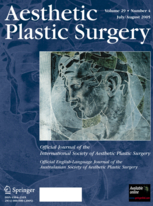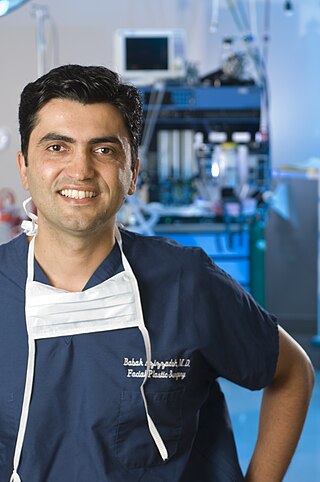
Plastic surgery is a surgical specialty involving the restoration, reconstruction or alteration of the human body. It can be divided into two main categories: reconstructive surgery and cosmetic surgery. Reconstructive surgery includes craniofacial surgery, hand surgery, microsurgery, and the treatment of burns. While reconstructive surgery aims to reconstruct a part of the body or improve its functioning, cosmetic surgery aims at improving the appearance of it.

Eye surgery, also known as ophthalmic or ocular surgery, is surgery performed on the eye or its adnexa, by an ophthalmologist. Eye surgery is part of ophthalmology. The eye is a fragile organ, and requires due care before, during, and after a surgical procedure to minimize or prevent further damage. An eye surgeon is responsible for selecting the appropriate surgical procedure for the patient, and for taking the necessary safety precautions. Mentions of eye surgery can be found in several ancient texts dating back as early as 1800 BC, with cataract treatment starting in the fifth century BC. It continues to be a widely practiced class of surgery, with various techniques having been developed for treating eye problems.

An eyelid is a thin fold of skin that covers and protects an eye. The levator palpebrae superioris muscle retracts the eyelid, exposing the cornea to the outside, giving vision. This can be either voluntarily or involuntarily. The human eyelid features a row of eyelashes along the eyelid margin, which serve to heighten the protection of the eye from dust and foreign debris, as well as from perspiration. "Palpebral" means relating to the eyelids. Its key function is to regularly spread the tears and other secretions on the eye surface to keep it moist, since the cornea must be continuously moist. They keep the eyes from drying out when asleep. Moreover, the blink reflex protects the eye from foreign bodies.
Oral and maxillofacial surgery is a surgical specialty focusing on reconstructive surgery of the face, facial trauma surgery, the oral cavity, head and neck, mouth, and jaws, as well as facial cosmetic surgery/facial plastic surgery including cleft lip and cleft palate surgery.

Blepharoplasty is the plastic surgery operation for correcting defects, deformities, and disfigurations of the eyelids; and for aesthetically modifying the eye region of the face. With the excision and the removal, or the repositioning of excess tissues, such as skin and adipocyte fat, and the reinforcement of the corresponding muscle and tendon tissues, the blepharoplasty procedure resolves functional and cosmetic problems of the periorbita, which is the area from the eyebrow to the upper portion of the cheek. The procedure is more common among women, who accounted for approximately 85% of blepharoplasty procedures in 2014 in the US and 88% of such procedures in the UK.

Hypertelorism is an abnormally increased distance between two organs or bodily parts, usually referring to an increased distance between the orbits (eyes), or orbital hypertelorism. In this condition the distance between the inner eye corners as well as the distance between the pupils is greater than normal. Hypertelorism should not be confused with telecanthus, in which the distance between the inner eye corners is increased but the distances between the outer eye corners and the pupils remain unchanged.

JAMA Facial Plastic Surgery was a peer-reviewed medical journal published by the American Medical Association. It was established in 1999 as the Archives of Facial Plastic Surgery. The founding editor was Wayne F Larrabee Jr. The title was changed in 2013 in concert with founding of the JAMA Network and rebranding of associated specialty journals. Its content included all aspects of reconstructive and cosmetic surgery of the head and neck.

The Queen Victoria Hospital (QVH), located in East Grinstead, West Sussex, England is the specialist reconstructive surgery centre for the south east of England, and also provides services at clinics across the region. It has become world-famous for its pioneering burns and plastic surgery. The hospital was named after Queen Victoria. It is managed by the Queen Victoria Hospital NHS Foundation Trust.
Oculoplastics, or oculoplastic surgery, includes a wide variety of surgical procedures that deal with the orbit, eyelids, tear ducts, and the face. It also deals with the reconstruction of the eye and associated structures.

Rod J. Rohrich, F.A.C.S. is a Dallas-based plastic surgeon, author and educator. He is the editor-in-chief of the journal Plastic and Reconstructive Surgery and a founding member of the Dallas Plastic Surgery Institute and the Alliance in Reconstructive Surgery.

New York Eye and Ear Infirmary of Mount Sinai (NYEE) is located at East 14th Street and Second Avenue in lower Manhattan, New York City. Founded on August 14, 1820, NYEE is America's first specialty hospital and one of the most prominent in the fields of ophthalmology and otolaryngology in the world, providing primary inpatient and outpatient care in those specialties. Previously affiliated with New York Medical College, as of 2013 it is affiliated with the Icahn School of Medicine at Mount Sinai as a part of the membership in the Mount Sinai Health System.
Aesthetic medicine is a branch of modern medicine that focuses on altering cosmetic appearance through the treatment of conditions including scars, skin laxity, wrinkles, moles, liver spots, excess fat, cellulite, unwanted hair, skin discoloration, and spider veins. Traditionally, it includes dermatology, oral and maxillofacial surgery, reconstructive surgery and plastic surgery, surgical procedures, non-surgical procedures, and a combination of both. Aesthetic medicine procedures are usually elective. There is a long history of aesthetic medicine procedures, dating back to many notable cases in the 19th century, though techniques have developed much since then.
Raman Malhotra is a British ophthalmologist and oculoplastic surgeon. He is a consultant ophthalmic surgeon and head of the Corneoplastic unit, Queen Victoria Hospital, East Grinstead.

Aesthetic Plastic Surgery is a bimonthly peer-reviewed medical journal covering all aspects of aesthetic plastic surgery. It was established in 1976 and is published by Springer Science+Business Media on behalf of the International Society of Aesthetic Plastic Surgery. It is the official journal of the European Association of Societies of Aesthetic Plastic Surgery and the Sociedade Brasileira de Cirurgia Plastica. The editor-in-chief is Bahman Guyuron
Robert Malcolm Goldwyn was an American surgeon; an author, activist, Professor of Surgery at Harvard Medical School, and Chief of Plastic Surgery at the Beth Israel Hospital from 1972 to 1996. He was the editor-in-chief of Plastic and Reconstructive Surgery for 25 years.

Aesthetic Surgery Journal is a peer-reviewed medical journal that covers the field of plastic surgery. The journal's editor-in-chief is Foad Nahai. It was established in 1996 as Aesthetic Surgery Quarterly and is currently published by Oxford University Press on behalf of the American Society for Aesthetic Plastic Surgery (ASAPS). Aesthetic Surgery Journal was indexed with MEDLINE/PubMed in 2008 and with the Thomson Reuters’ Journal Citation Reports in 2011. Aesthetic Surgery Journal’s current impact factor is 4.283. In the 2014 JCR, Aesthetic Surgery Journal ranked 82nd out of 198 journals in the overall “Surgery” category.

Babak Azizzadeh, MD, FACS is the founder and president of the FPBPF, a non-profit organization committed to the treatment of individuals with facial nerve paralysis and Bell's palsy.
Gerd Geerling is a German consultant ophthalmic surgeon, Professor of Ophthalmology and since 2011 head of the Universitäts-Augenklinik Düsseldorf of the University of Düsseldorf, Germany.
The Universitäts-Augenklinik Düsseldorf is the department of Ophthalmology of the University Hospital of Düsseldorf in Germany. It is an internationally renown centre for corneal transplantation, ocular surface disease and management of associated disorders ranging from Glaucoma to oculoplastic surgery. Further subspecialist expertise is established for the diagnosis and surgical and medical treatment of vitreoretinal and macular disorders as well as strabismus.
Akshay Nair is an Indian ophthalmologist based in Mumbai, India. He specializes in oculoplastics, orbital surgery and ocular oncology. Currently, Dr. Nair is the Director of Ophthalmic plastic surgery and ocular oncology services at the Mumbai units of Dr. Agarwal's Eye Hospital: Advanced Eye Hospital and Institute and Aditya Jyot Eye Hospital.












